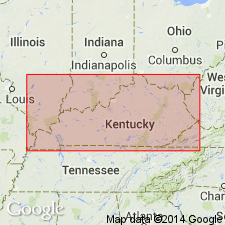
- Usage in publication:
-
- Flint Ridge flint
- Modifications:
-
- Original reference
- Dominant lithology:
-
- Flint
- Chert
- AAPG geologic province:
-
- Appalachian basin
Summary:
Pg. 296, 305. Flint Ridge flint. A 3-foot bed of yellow, non-fossiliferous flint, lying 30 feet below top of Flint Ridge at head of Leatherwood Branch of South Quicksand Creek, Troublesome quadrangle, and near 1,500-foot contour line, Breathitt County, eastern Kentucky; it also lies 550 feet, by barometer, above Magoffin beds, and 370 feet above Lost Creek limestone. Loose dolomitic or leached limestone blocks associated with the flint are very fossiliferous. The Flint Ridge flint has not been recognized outside of this area. Age is Pennsylvanian.
Source: US geologic names lexicon (USGS Bull. 896, p. 743).
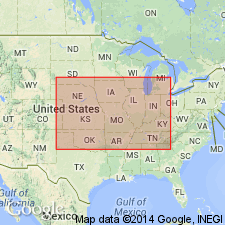
- Usage in publication:
-
- Flint Ridge flint [unranked]
- Modifications:
-
- Revised
- AAPG geologic province:
-
- Appalachian basin
Summary:
Chart no. 6 (column 22, Kentucky River valley, eastern Kentucky, collated by H.R. Wanless and J.M. Weller). Flint Ridge flint [unranked]. Shown on Pennsylvanian correlation chart as occurring in upper part of Breathitt formation. Lies below Stamper(?) coal and above Lost Creek limestone, both unranked units assigned to Breathitt formation. Age is [Middle Pennsylvanian]; Alleghany; Desmoinesian; Westphalian C.
[Shown on chart correlative with Kanawha flint in southern West Virginia (col. 12) and Zaleski flint in Ohio (col. 10).]
Source: Publication; US geologic names lexicon (USGS Bull. 1200, p. 1374).
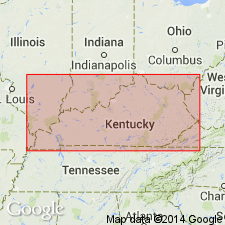
- Usage in publication:
-
- Flint Ridge flint
- Modifications:
-
- Revised
- AAPG geologic province:
-
- Appalachian basin
Summary:
Breathitt Formation is informally elevated to group rank and subdivided into the following eight informal formations: Pocahontas, Bottom Creek, Alvy Creek, Grundy, Pikeville, Hyden, Four Corners, and Princess formations. Kilgore flint and the Flint Ridge flint [both treated informally] are approximately at the same stratigraphic level, overlying the Richardson coal bed and therefore are treated together here as the Flint Ridge flint, and assigned to the Princess formation. The Flint Ridge underlies Princess Nos. 5A and 5B coals. Age shown as Middle Pennsylvanian (Atokan). [Revisions made in this paper are strongly contested by C. Rice and other USGS scientists who work in this area (oral commun., 9/3/93).]
Source: GNU records (USGS DDS-6; Reston GNULEX).
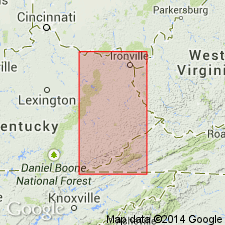
- Usage in publication:
-
- Flint Ridge flint*
- Modifications:
-
- Areal extent
- AAPG geologic province:
-
- Appalachian basin
Summary:
Flint Ridge flint (informal, unranked; of Morse, 1931) in Breathitt Formation. (Is = Limekiln limestone of Johnston, 1962, USGS GQ-181, in Lenox quadrangle, Licking River district, eastern Kentucky; and Kilgore Flint Member in Princess district, eastern Kentucky.) [Flint in upper part of Breathitt Formation about 40 feet above top of Skyline coal zone (or Richardson, Knob coal zones). Correlates with Putnam Hill Limestone Member of Allegheny Formation in Ohio and Kanawha black flint of White (1891) in West Virginia. Fossils.] Age is Middle Pennsylvanian.
Recognized locally in Hazard district, eastern KY.
[See Rice and others, 1994, GSA Spec. Paper 294, p. 11-13; see also Rice and others, same vol., p. 126.]
Source: Publication.
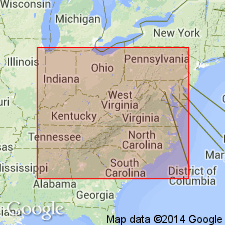
- Usage in publication:
-
- Flint Ridge flint
- Modifications:
-
- Areal extent
- AAPG geologic province:
-
- Appalachian basin
Summary:
Corr. chart. Flint Ridge flint. Included with Kilgore Flint Member of Princess Formation of Breathitt Group in eastern Kentucky. Age is Middle Pennsylvanian (Westphalian; late Atokan). [See entries under Kilgore.]
Source: Publication.
For more information, please contact Nancy Stamm, Geologic Names Committee Secretary.
Asterisk (*) indicates published by U.S. Geological Survey authors.
"No current usage" (†) implies that a name has been abandoned or has fallen into disuse. Former usage and, if known, replacement name given in parentheses ( ).
Slash (/) indicates name conflicts with nomenclatural guidelines (CSN, 1933; ACSN, 1961, 1970; NACSN, 1983, 2005, 2021). May be explained within brackets ([ ]).

